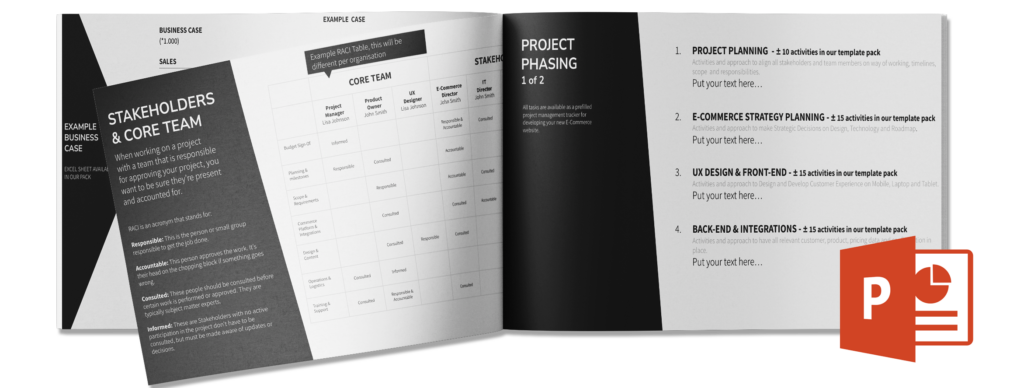As a project manager for E-commerce Websites, it is important to have a basic understanding of front-end technology in order to effectively lead a team of front-end developers. With a strong foundation in front-end technologies, you will be better able to communicate with your team, understand their work, and provide valuable input and guidance. (Be sure to also read my Article with 14 tips to work together with a team of front-end developers)
Additionally, having a technical understanding will allow you to make informed decisions about the direction of the project and identify potential issues or challenges that may arise. Without a basic understanding of front-end technology, you may struggle to effectively manage your team and ensure that the project is completed on time and to a high standard.
HTML, CSS, and JavaScript are the three cornerstone technologies of the Web. HTML is used to structure and organize content on the web, CSS is used to style and layout that content, and JavaScript is used to add interactivity and dynamic behavior to web pages.
While HTML, CSS, and JavaScript are essential for building web eCommerce Websites, they can be time-consuming and tedious to work with, especially for larger and more complex projects. This is where frameworks like React and Angular come in.
The use of Components
In React, apps are built using small, reusable blocks of code called components. These components are an essential part of React apps and allow for the creation of the user interface (UI) for a website by dividing the UI into smaller pieces. When these components are combined, they form the complete UI for the website. Unlike traditional JavaScript, apps in React are not constructed as a single, lengthy file but rather as a series of components.

When building large e-commerce websites, it is common to encounter recurring patterns. In React, these patterns can be grouped into components and reused throughout the project. For example, if you are building an e-commerce website and need to display cards for different products, you can create a component for the card and reuse it throughout the website by providing different data sets for each product. This helps to streamline the development process and make it easier to maintain the website over time.
Impact on Website Speed
React utilizes a virtual Document Object Model (DOM) to improve the performance of web applications. When a change is made to a component, React compares the updated virtual DOM with the previous version to determine the minimal changes necessary. These changes are then made to the real DOM, making the update process more efficient. In contrast to the real DOM, the virtual DOM only updates the specific changes rather than re-rendering the entire DOM tree, including the target node. As a result, React-based websites tend to be faster than those built solely with JavaScript, where the entire DOM must be re-rendered with each update.
Easier for Complex ECommerce Websites
For simple, static websites, using vanilla JavaScript may not be a significant issue. However, for complex web applications that require frequent changes to the DOM and fast loading times, using plain JavaScript can become cumbersome. In these cases, React’s virtual DOM can be a valuable tool as it only updates the necessary elements of the real DOM rather than re-rendering the entire structure. Additionally, React’s component-based architecture allows for the reuse of components, further streamlining the development process. Overall, React’s virtual DOM and component-based approach make it a powerful choice for building complex web applications.
Maintenance of your Commerce Website
One of the major benefits of building websites with components is improved maintainability. In the past, it was often difficult to predict how changing the margin of an HTML element would affect the overall website. With React, each component acts independently, making it easy to update and track their behavior on different viewports. This allows developers to make updates to individual components without worrying about unintended consequences on the rest of the website. Overall, this component-based approach makes it easier to maintain and update websites built with React.

React and Angular?
React and Angular are JavaScript libraries that were developed to make it easier to build and maintain large eCommerce Websites. Both React and Angular provide a set of tools and features that allow developers to create powerful and efficient web applications more quickly and easily.
One of the key differences between React and Angular is the way they approach rendering content to the screen. React uses a virtual DOM (Document Object Model) to update the view when the state of a component changes, while Angular uses a template-based syntax to update the view.
Another difference between the two frameworks is the way they handle data binding. React uses a unidirectional data flow, meaning that data flows in one direction from the parent component to the child component. Angular, on the other hand, uses two-way data binding, which means that changes in the view are automatically reflected in the component’s data model, and vice versa.
Overall, React and Angular are both powerful and popular frameworks for building web applications, and which one you choose will depend on your specific needs and preferences. Both frameworks have their own strengths and weaknesses, and the best choice will depend on the specific requirements of your project.
Angular as a Framework for E-Commerce
Google developed Angular in 2016 as a TypeScript-based JavaScript framework. Angular has been widely adopted by companies such as Google, Microsoft, and Forbes for their websites and applications. Angular is based on its predecessor, AngularJS, which was released in 2010. It is known for its two-way data binding, automatic synchronization of client data and the database, and its monolithic framework that allows for the development of various components within a single platform. These features make Angular a strong choice for e-commerce application development, particularly for Single Page Applications (SPAs).
In addition to its capabilities for e-commerce development, Angular is an open-source platform that does not require additional libraries for mobile or web application development. It is particularly well-suited for complex, heavy applications.
There are several benefits to using Angular for e-commerce application development, including its open-source status, suitability for complex SPAs, reusable components, and comprehensive libraries. However, Angular does have a steep learning curve and requires a strong understanding of TypeScript and the Model-View-Controller methodology.
React as a Framework for E-Commerce
The orther popular open-source, JavaScript-based front-end framework for eCommerce product development is React. It was created by Jordan Walke – a software engineer at Facebook (now known as Meta). This popular framework has been used for the front-end development of significant websites and applications such as Netflix, PayPal, and BBC. React is best suited for designing creative and interactive user interfaces, developing reusable components, search engine optimization, creating code packages for applications, and developing highly scalable projects.
Its declarative views such as DOM (Document Object Models) and React Hooks have played significant roles in bagging the top framework position for React. While DOM makes the code more readable and easier to understand, React Hooks allows developers to use various framework features without defining a class first. Additionally, using JavaScript Syntax Extension (JSX) for writing React components makes it easier for developers to make the syntax identical to HTML and access the components. Lastly, React promises seamless integration and migration, making it more popular with the developer community, especially for eCommerce applications.
Advantages of using React for eCommerce product development An open-source platform for efficient website and application development It is easy to learn because of its JSX-based syntax, which makes the code very similar to HTML. SEO friendly Codes compiled in React execute faster due to the implementation of DOM. Allows reusing of components Migration and Integration friendly Best suited for building user interfaces A large developer community that offers around-the-clock support. The framework is frequently updated to provide users with the latest tools, libraries, and developing environment.
Disadvantages of choosing React for application development It is challenging to keep the React framework up-to-date since it is tedious to find detailed documentation, including React’s latest additions and updates.


